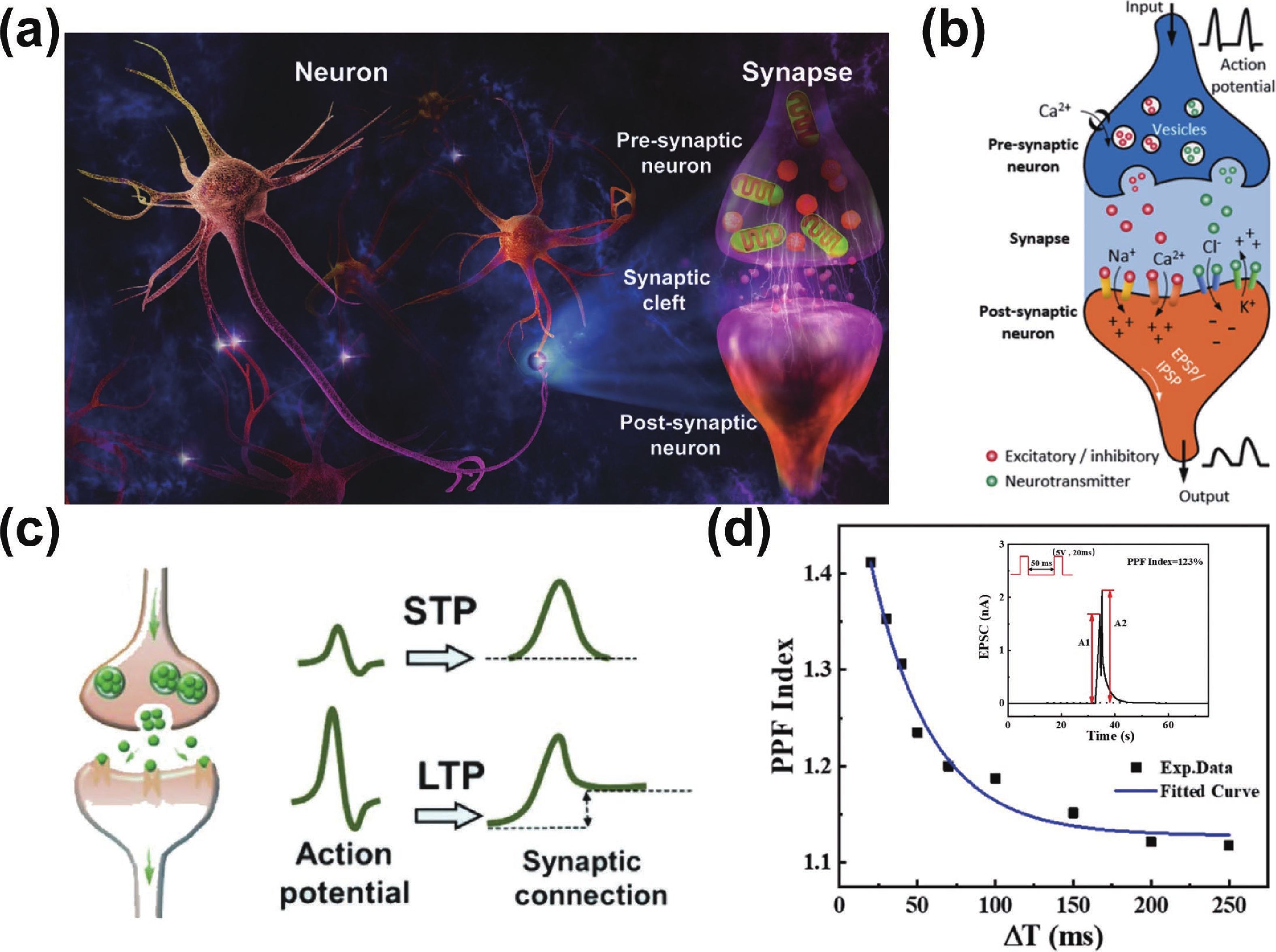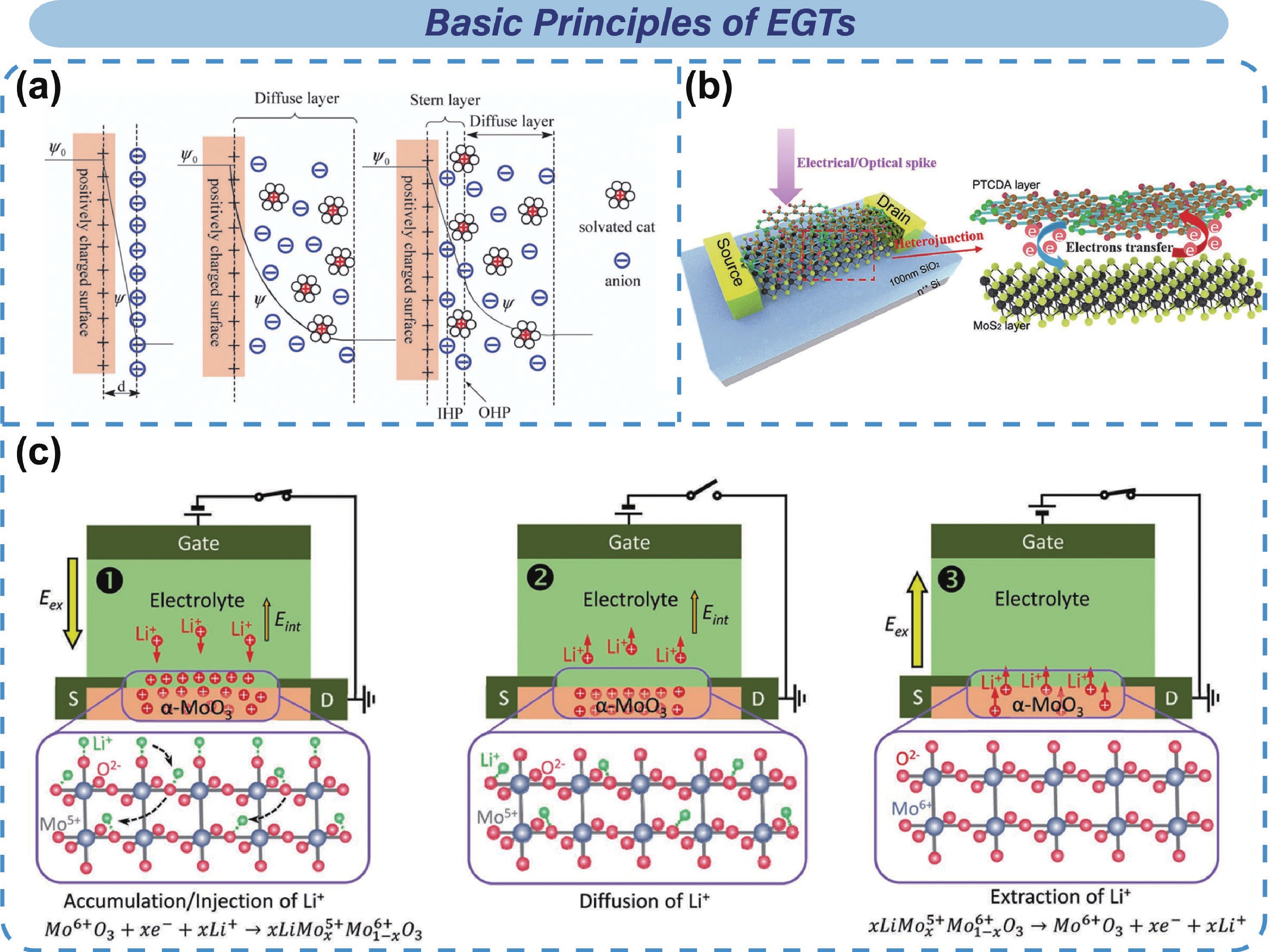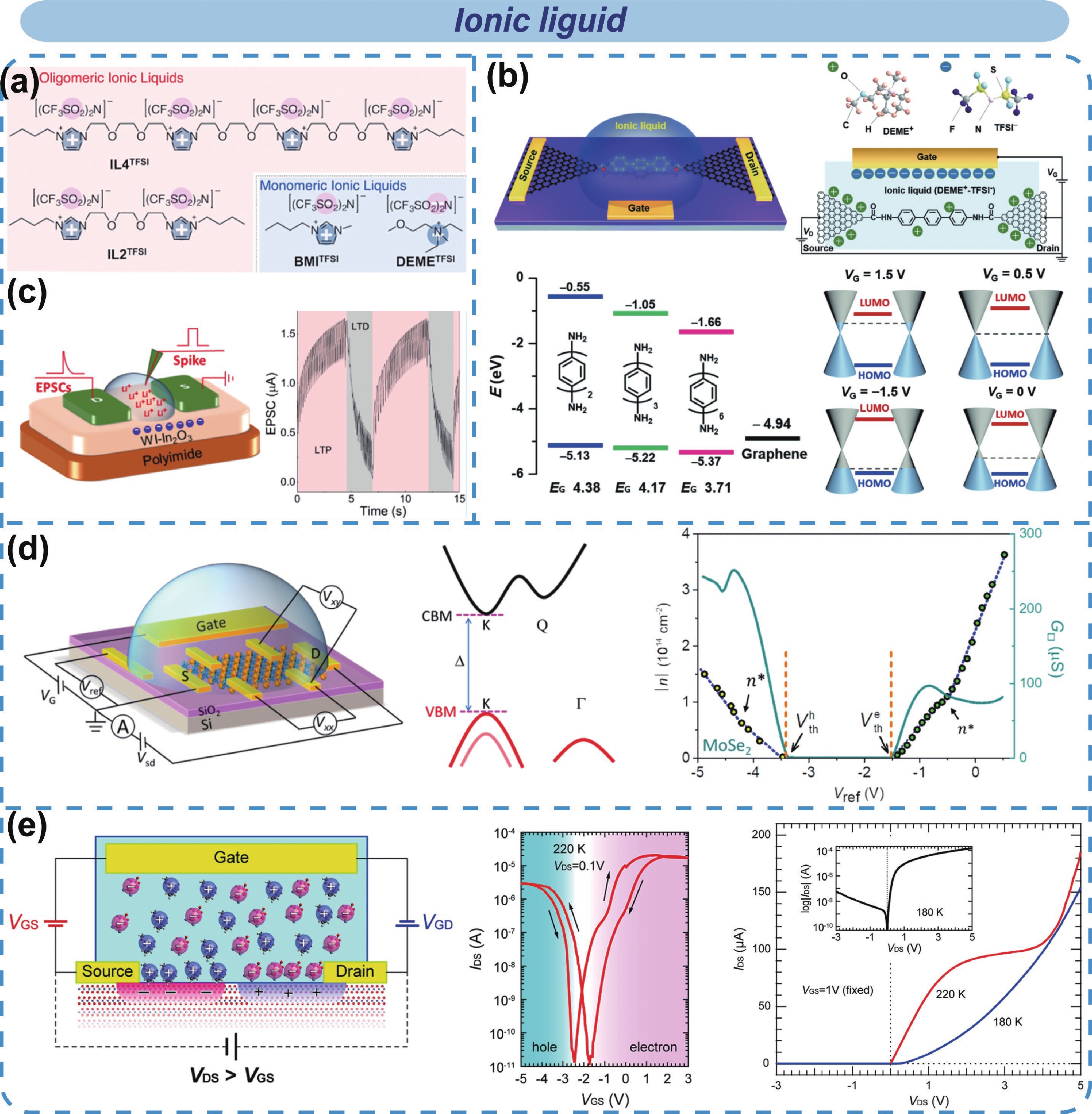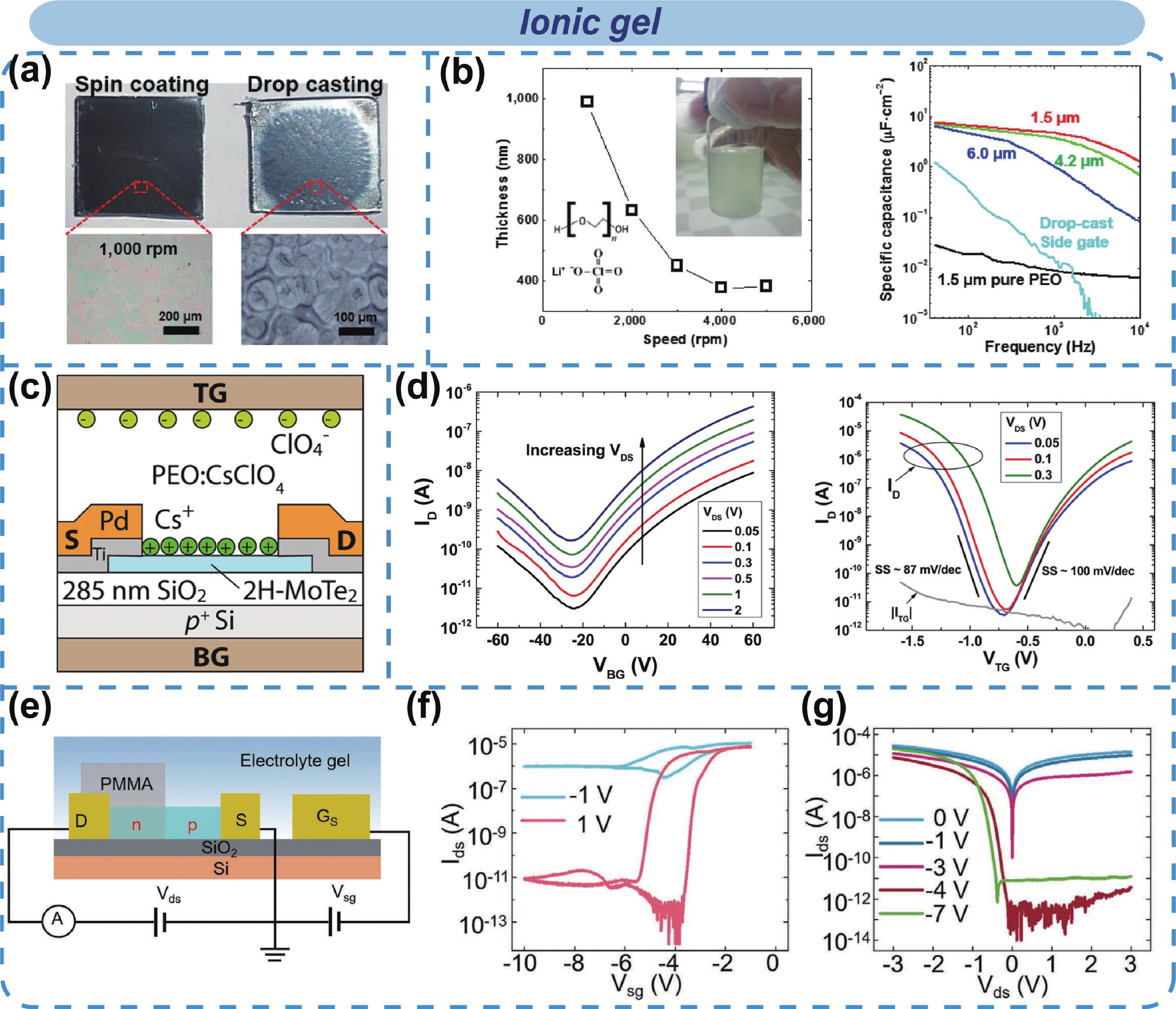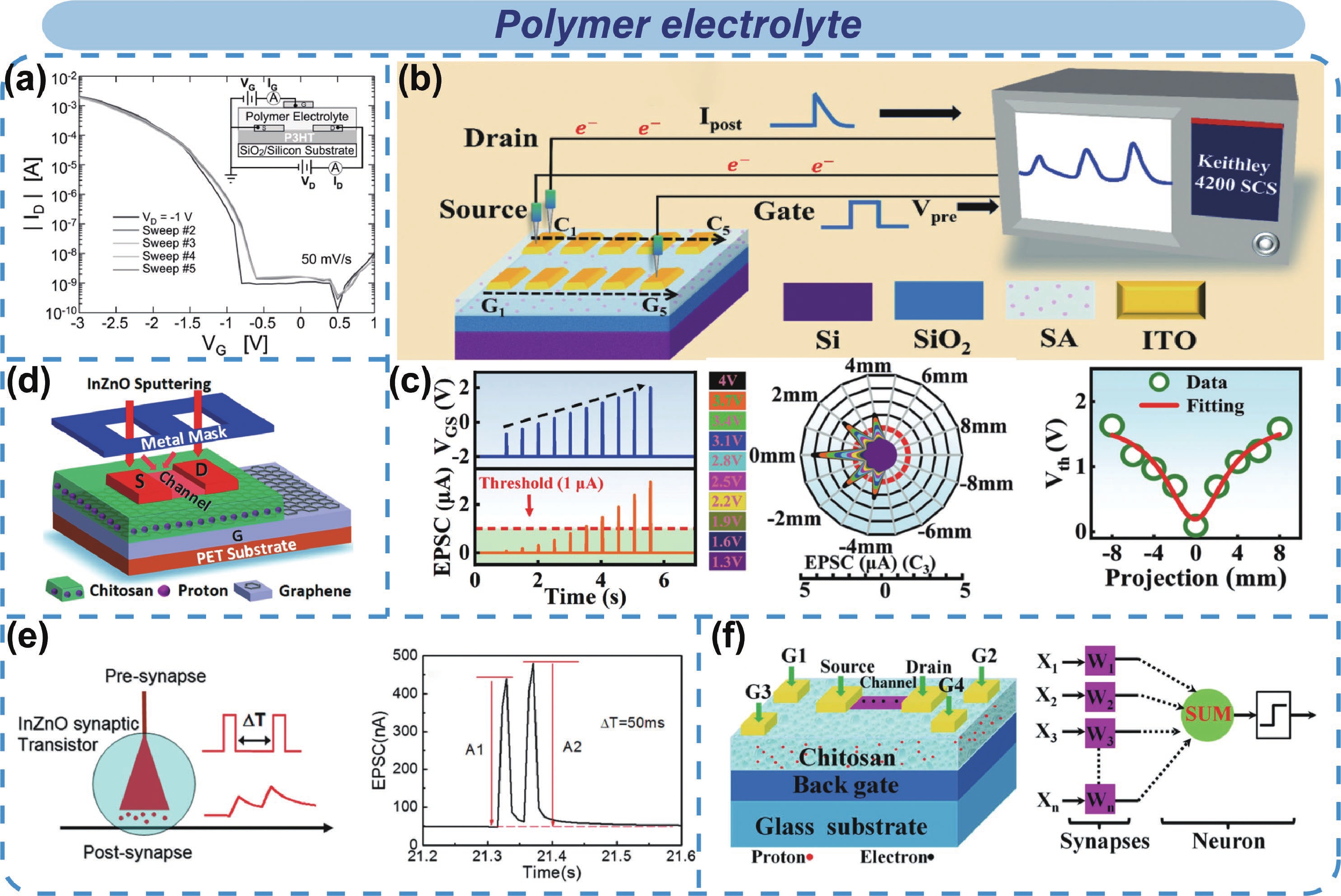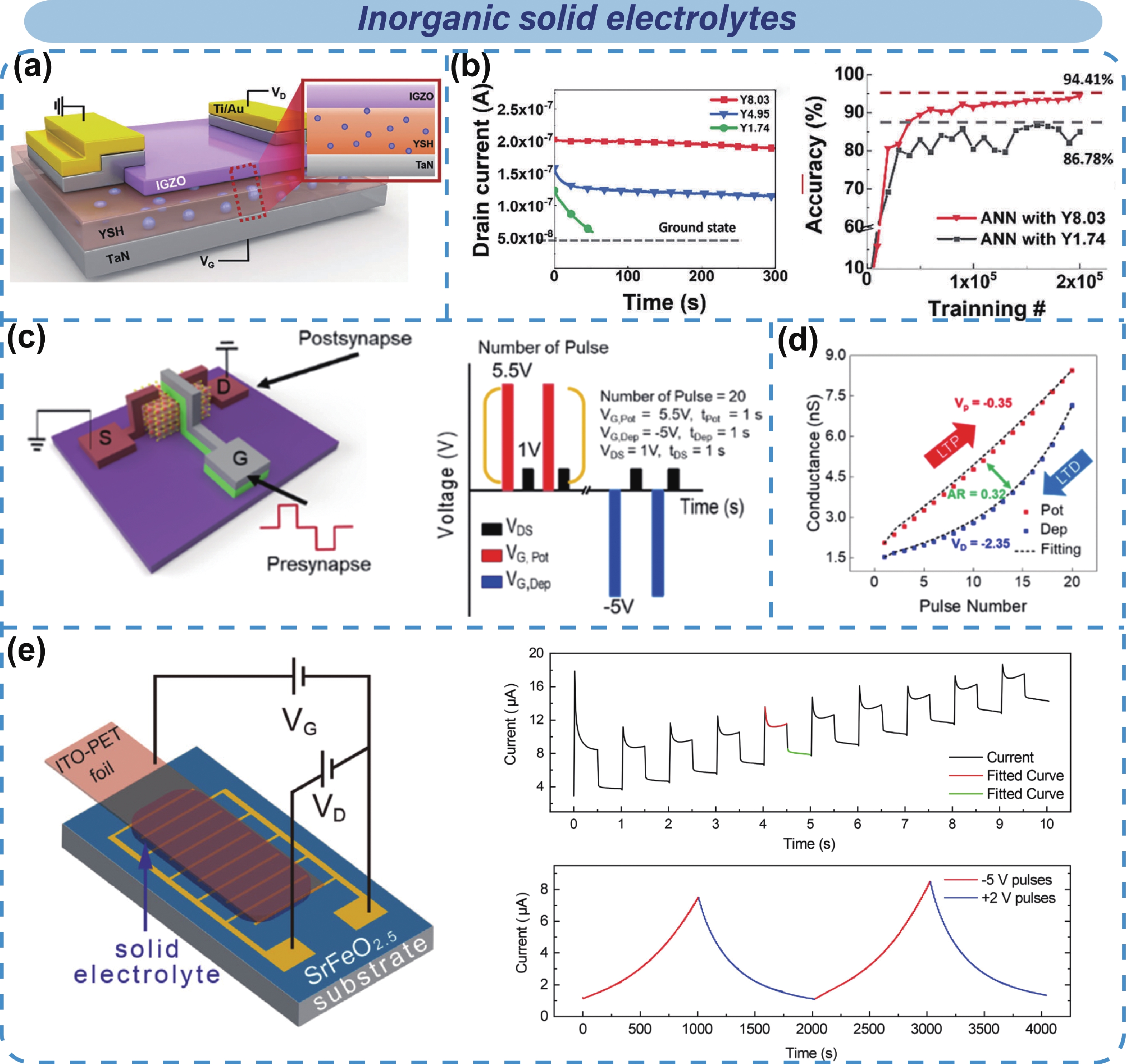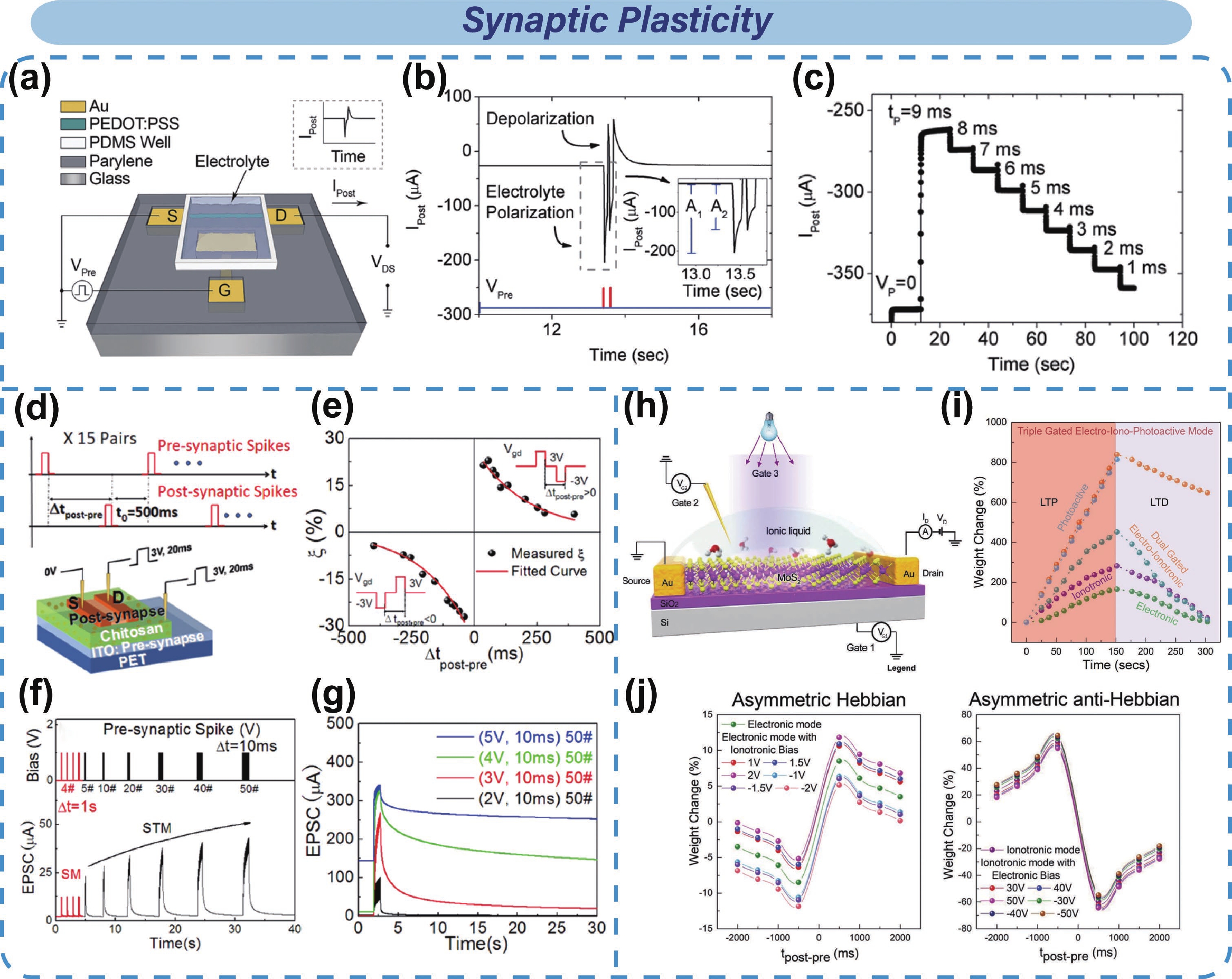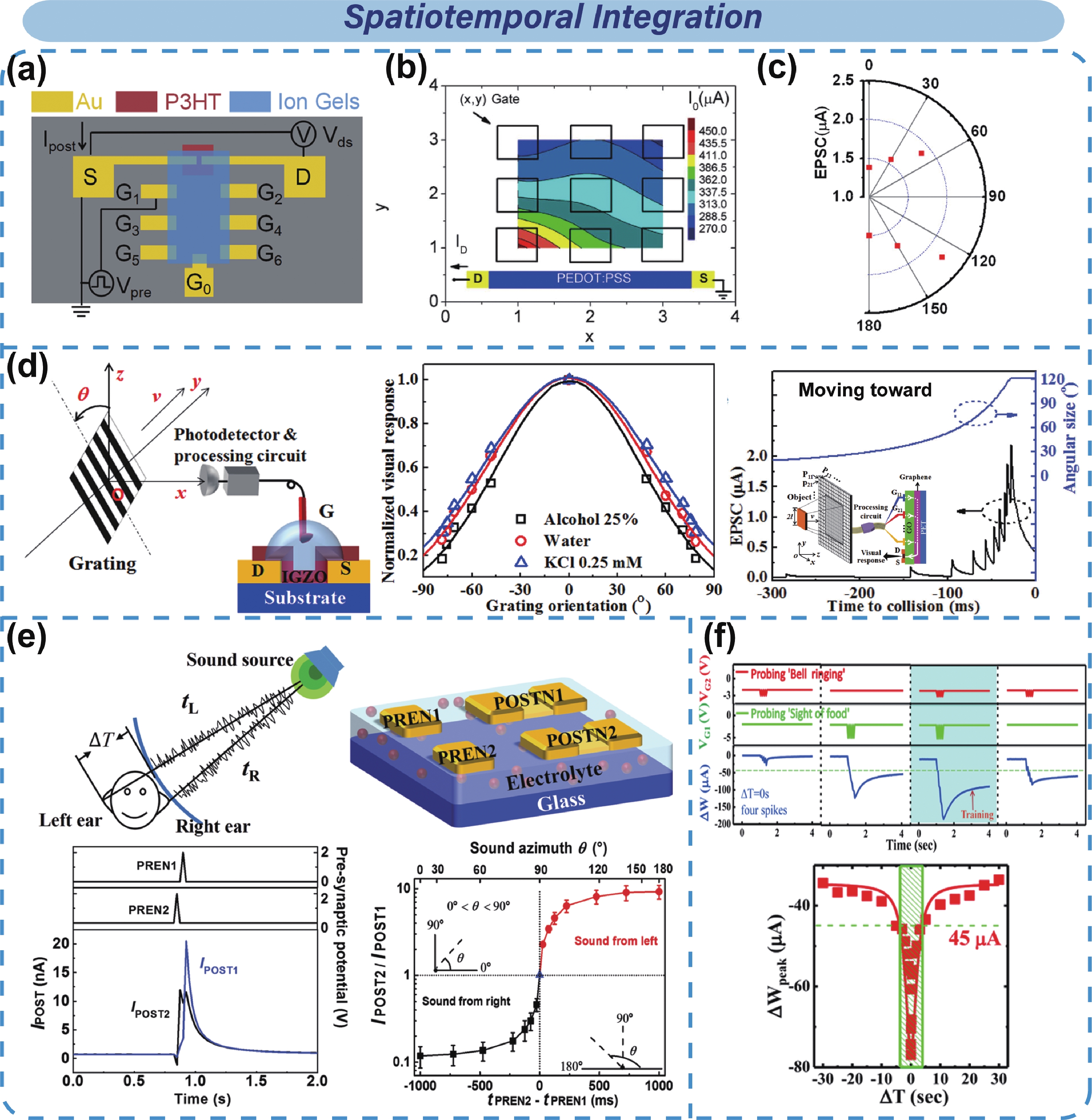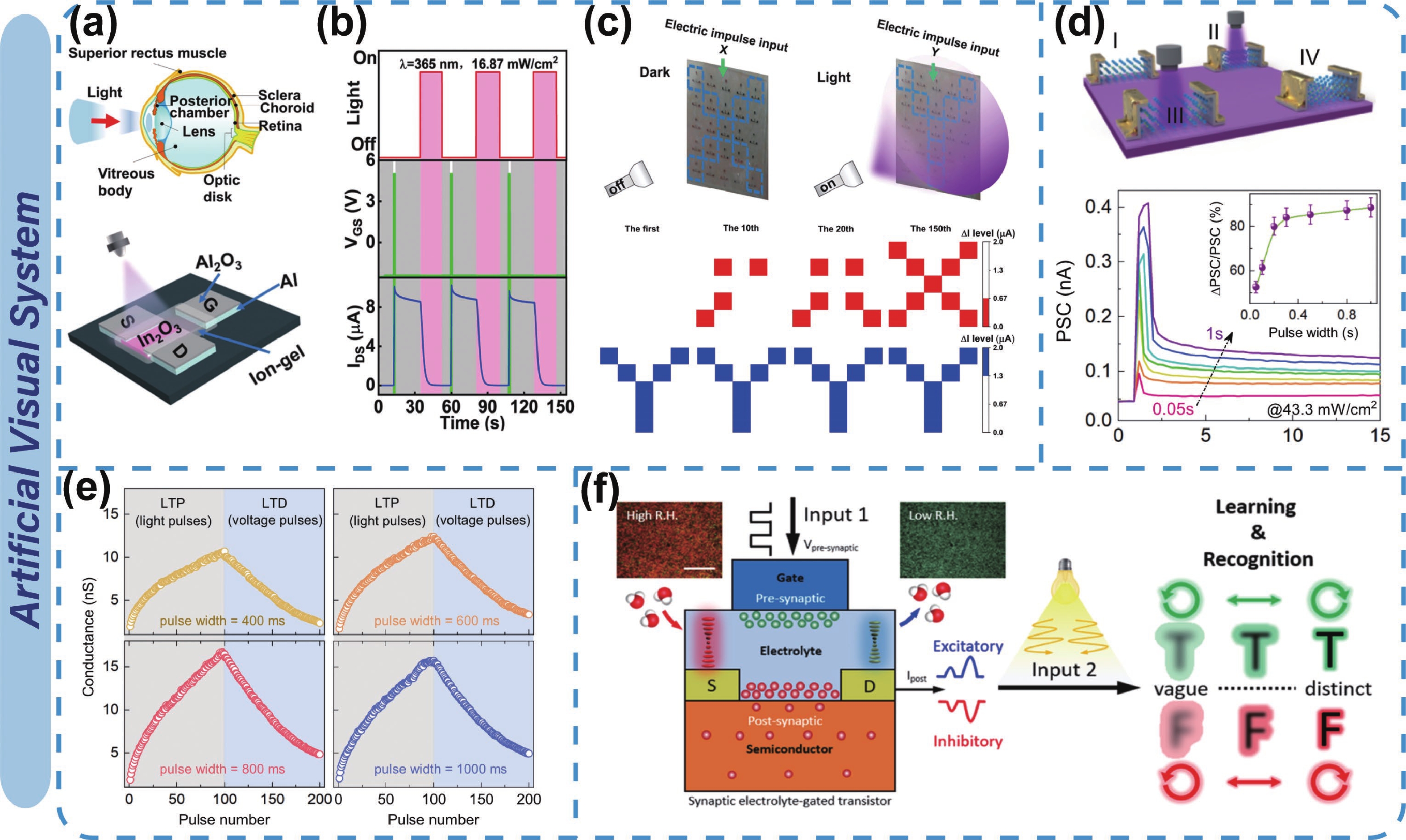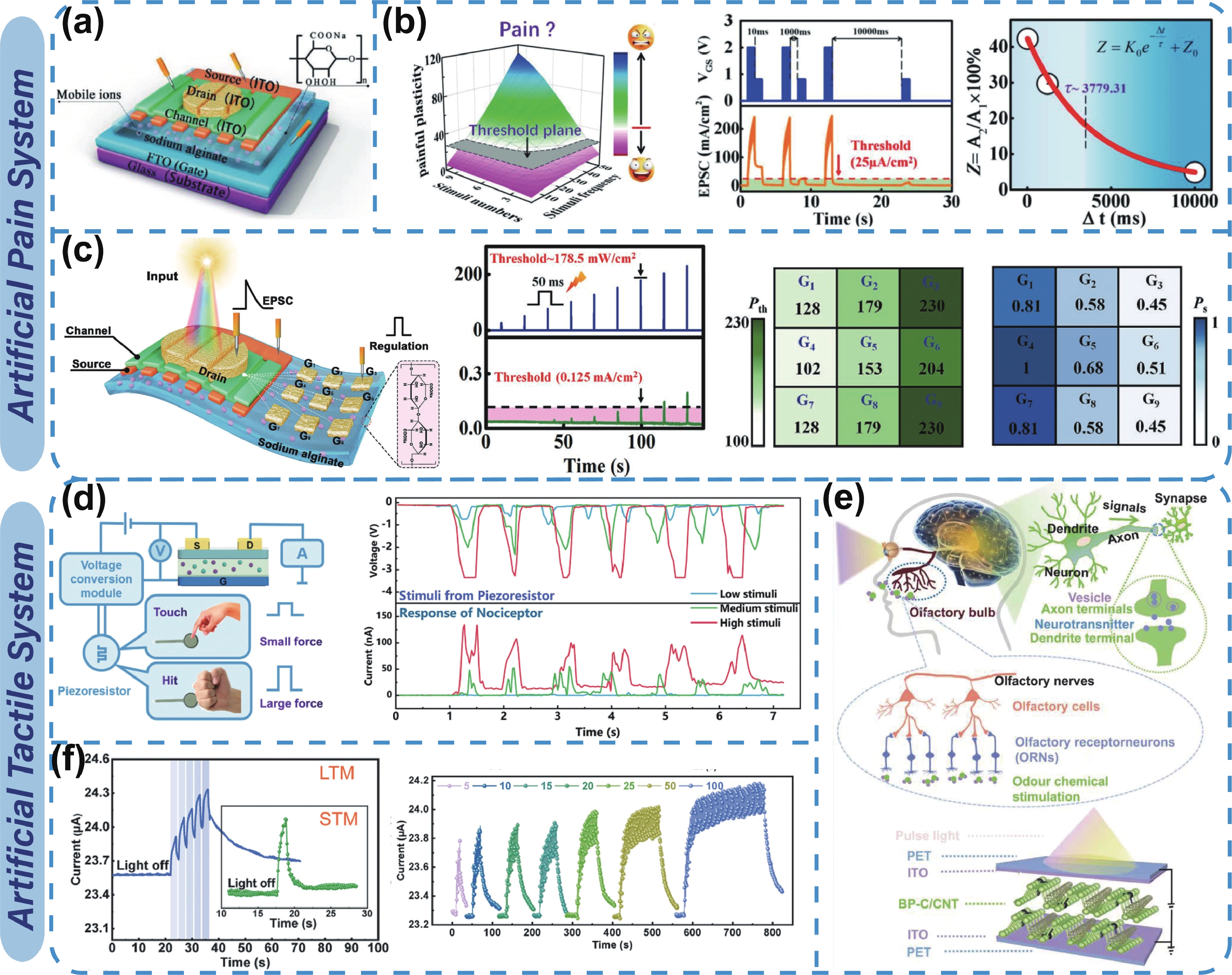| Citation: |
Jinming Bi, Yanran Li, Rong Lu, Honglin Song, Jie Jiang. Electrolyte-gated optoelectronic transistors for neuromorphic applications[J]. Journal of Semiconductors, 2025, 46(2): 021401. doi: 10.1088/1674-4926/24090042
****
J M Bi, Y R Li, R Lu, H L Song, and J Jiang, Electrolyte-gated optoelectronic transistors for neuromorphic applications[J]. J. Semicond., 2025, 46(2), 021401 doi: 10.1088/1674-4926/24090042
|
Electrolyte-gated optoelectronic transistors for neuromorphic applications
DOI: 10.1088/1674-4926/24090042
CSTR: 32376.14.1674-4926.24090042
More Information-
Abstract
The traditional von Neumann architecture has demonstrated inefficiencies in parallel computing and adaptive learning, rendering it incapable of meeting the growing demand for efficient and high-speed computing. Neuromorphic computing with significant advantages such as high parallelism and ultra-low power consumption is regarded as a promising pathway to overcome the limitations of conventional computers and achieve the next-generation artificial intelligence. Among various neuromorphic devices, the artificial synapses based on electrolyte-gated transistors stand out due to their low energy consumption, multimodal sensing/recording capabilities, and multifunctional integration. Moreover, the emerging optoelectronic neuromorphic devices which combine the strengths of photonics and electronics have demonstrated substantial potential in the neuromorphic computing field. Therefore, this article reviews recent advancements in electrolyte-gated optoelectronic neuromorphic transistors. First, it provides an overview of artificial optoelectronic synapses and neurons, discussing aspects such as device structures, operating mechanisms, and neuromorphic functionalities. Next, the potential applications of optoelectronic synapses in different areas such as artificial visual system, pain system, and tactile perception systems are elaborated. Finally, the current challenges are summarized, and future directions for their developments are proposed. -
References
[1] Shastri B J, Tait A N, Ferreira de Lima T, et al. Photonics for artificial intelligence and neuromorphic computing. Nat Photonics, 2021, 15, 102 doi: 10.1038/s41566-020-00754-y[2] Wu J M, Lin X, Guo Y C, et al. Analog optical computing for artificial intelligence. Engineering, 2022, 10, 133 doi: 10.1016/j.eng.2021.06.021[3] Tang J S, Yuan F, Shen X K, et al. Bridging biological and artificial neural networks with emerging neuromorphic devices: Fundamentals, progress, and challenges. Adv Mater, 2019, 31, 1902761 doi: 10.1002/adma.201902761[4] Wan L. High χ polystyrene-b-polycarbonate for next generation lithography. Sci China Chem, 2017, 60, 679 doi: 10.1007/s11426-017-9043-7[5] Manipatruni S, Nikonov D E, Young I A. Beyond CMOS computing with spin and polarization. Nat Phys, 2018, 14, 338 doi: 10.1038/s41567-018-0101-4[6] Meng L N, Xin N, Hu C, et al. Dual-gated single-molecule field-effect transistors beyond Moore’s law. Nat Commun, 2022, 13, 1410 doi: 10.1038/s41467-022-28999-x[7] Li Y S, Xiong Y, Zhai B X, et al. Ag-doped non–imperfection-enabled uniform memristive neuromorphic device based on van der Waals indium phosphorus sulfide. Sci Adv, 2024, 10, eadk9474 doi: 10.1126/sciadv.adk9474[8] Niu X Z, Tian B B, Zhu Q X, et al. Ferroelectric polymers for neuromorphic computing. Appl Phys Rev, 2022, 9, 021309 doi: 10.1063/5.0073085[9] Wang S Y, Liu X X, Zhou P. The road for 2D semiconductors in the silicon age. Adv Mater, 2022, 34, 2106886 doi: 10.1002/adma.202106886[10] Liu S Z, Zeng J M, Wu Z X, et al. An ultrasmall organic synapse for neuromorphic computing. Nat Commun, 2023, 14, 7655 doi: 10.1038/s41467-023-43542-2[11] Cao Y X, Yin L, Zhao C, et al. Perovskite-based optoelectronic systems for neuromorphic computing. Nano Energy, 2024, 120, 109169 doi: 10.1016/j.nanoen.2023.109169[12] Ma F M, Zhu Y B, Xu Z W, et al. Optoelectronic perovskite synapses for neuromorphic computing. Adv Funct Mater, 2020, 30, 1908901 doi: 10.1002/adfm.201908901[13] Xue S W, Wang S Y, Wu T X, et al. Hybrid neuromorphic hardware with sparing 2D synapse and CMOS neuron for character recognition. Sci Bull, 2023, 68, 2336 doi: 10.1016/j.scib.2023.09.006[14] Wu F C, Chou C H, Tseng T Y. CMOS-compatible memristor for optoelectronic neuromorphic computing. Nanoscale Res Lett, 2022, 17, 105 doi: 10.1186/s11671-022-03744-x[15] He Z Y, Wang T Y, Meng J L, et al. CMOS back-end compatible memristors for in situ digital and neuromorphic computing applications. Mater Horiz, 2021, 8, 3345 doi: 10.1039/D1MH01257F[16] Zhu Y X, Mao H W, Zhu Y, et al. CMOS-compatible neuromorphic devices for neuromorphic perception and computing: A review. Int J Extrem Manuf, 2023, 5, 042010 doi: 10.1088/2631-7990/acef79[17] Nketia-Yawson B, Kang S J, Tabi G D, et al. Transistors: Ultrahigh mobility in solution-processed solid-state electrolyte-gated transistors. Adv Mater, 2017, 29, 1605685 doi: 10.1002/adma.201605685[18] Xu K, Lu H, Kinder E W, et al. Monolayer solid-state electrolyte for electric double layer gating of graphene field-effect transistors. ACS Nano, 2017, 11, 5453 doi: 10.1021/acsnano.6b08505[19] Ling H F, Koutsouras D A, Kazemzadeh S, et al. Electrolyte-gated transistors for synaptic electronics, neuromorphic computing, and adaptable biointerfacing. Appl Phys Rev, 2020, 7, 011307 doi: 10.1063/1.5122249[20] Yao B W, Li J Q, Chen X D, et al. Non-volatile electrolyte-gated transistors based on graphdiyne/MoS2 with robust stability for low-power neuromorphic computing and logic-In-memory. Adv Funct Mater, 2021, 31, 2100069 doi: 10.1002/adfm.202100069[21] Xu H, Shang D S, Luo Q, et al. A low-power vertical dual-gate neurotransistor with short-term memory for high energy-efficient neuromorphic computing. Nat Commun, 2023, 14, 6385 doi: 10.1038/s41467-023-42172-y[22] Jin M, Lee H, Lee J H, et al. Ferroelectrically modulated ion dynamics in Li+ electrolyte-gated transistors for neuromorphic computing. Appl Phys Rev, 2023, 10, 011407 doi: 10.1063/5.0130742[23] Zare Bidoky F, Frisbie C D. Sub-3 V, MHz-class electrolyte-gated transistors and inverters. ACS Appl Mater Interfaces, 2022, 14, 21295 doi: 10.1021/acsami.2c01585[24] Song H L, Li Y R, Huang Z H, et al. Flexible electrolyte-based devices for neuromorphic electronics. IEEE J Flex Electron, 2024, 3, 29 doi: 10.1109/JFLEX.2023.3335182[25] Qin J K, Zhou F C, Wang J L, et al. Anisotropic signal processing with trigonal selenium nanosheet synaptic transistors. ACS Nano, 2020, 14, 10018 doi: 10.1021/acsnano.0c03124[26] Yin L, Han C, Zhang Q T, et al. Synaptic Silicon-nanocrystal phototransistors for neuromorphic computing. Nano Energy, 2019, 63, 103859 doi: 10.1016/j.nanoen.2019.103859[27] Fu J T, Jiang H, Nie C B, et al. Polarity-tunable field effect phototransistors. Nano Lett, 2023, 23, 4923 doi: 10.1021/acs.nanolett.3c00728[28] Sun C, Liu X R, Yao Q X, et al. A discolorable flexible synaptic transistor for wearable health monitoring. ACS Nano, 2024, 18, 515 doi: 10.1021/acsnano.3c08357[29] Kwon S M, Kwak J Y, Song S, et al. Large-area pixelized optoelectronic neuromorphic devices with multispectral light-modulated bidirectional synaptic circuits. Adv Mater, 2021, 33, 2105017 doi: 10.1002/adma.202105017[30] Chen J X, Liu X Y, Zhu Q S, et al. 2D Ca2Nb3O10 optoelectronic neuromorphic device for ultrasensitive UV-C vision and encrypted communication. Adv Funct Mater, 2024, 34, 2402684 doi: 10.1002/adfm.202402684[31] Huang W, Zhang H X, Tang J W, et al. Self-powered optoelectronic synaptic devices for neuromorphic computing with the lowest energy consumption density. ACS Photonics, 2024, 11, 3095 doi: 10.1021/acsphotonics.4c00379[32] Wang X Y, Zong Y X, Liu D Y, et al. Advanced optoelectronic devices for neuromorphic analog based on low-dimensional semiconductors. Adv Funct Mater, 2023, 33, 2213894 doi: 10.1002/adfm.202213894[33] Liu Y, Wang B, Wu L, et al. Artificial visual synaptic architecture with high-linearity light-modulated weight for optoelectronic neuromorphic computing. ACS Appl Mater Interfaces, 2023, 15(44), 51380 doi: 10.1021/acsami.3c11495[34] Kumar D, Li H R, Das U K, et al. Flexible solution-processable black-phosphorus-based optoelectronic memristive synapses for neuromorphic computing and artificial visual perception applications. Adv Mater, 2023, 35, 2300446 doi: 10.1002/adma.202300446[35] Wang X, Ran Y X, Li X Q, et al. Bio-inspired artificial synaptic transistors: Evolution from innovative basic units to system integration. Mater Horiz, 2023, 10, 3269 doi: 10.1039/D3MH00216K[36] Yang J Q, Wang R P, Ren Y, et al. Neuromorphic engineering: From biological to spike-based hardware nervous systems. Adv Mater, 2020, 32, 2003610 doi: 10.1002/adma.202003610[37] Chen Y H, Gao G Y, Zhao J, et al. Piezotronic graphene artificial sensory synapse. Adv Funct Mater, 2019, 29, 1900959 doi: 10.1002/adfm.201900959[38] Yan X B, Li X Y, Zhou Z Y, et al. Flexible transparent organic artificial synapse based on the tungsten/egg albumen/indium tin oxide/polyethylene terephthalate memristor. ACS Appl Mater Interfaces, 2019, 11, 18654 doi: 10.1021/acsami.9b04443[39] Lan S Q, Zhong J F, Chen J W, et al. An optoelectronic synaptic transistor with efficient dual modulation by light illumination. J Mater Chem C, 2021, 9, 3412 doi: 10.1039/D0TC05738J[40] Ke Y D, Yu R J, Lan S Q, et al. Polymer bulk-heterojunction synaptic field-effect transistors with tunable decay constant. J Mater Chem C, 2021, 9, 4854 doi: 10.1039/D0TC05629D[41] Zhao J, Liu F, Huang Q, et al. Charge trap-based carbon nanotube transistor for synaptic function mimicking. Nano Res, 2021, 14, 4258 doi: 10.1007/s12274-021-3611-9[42] Yu H Y, Wei H H, Gong J D, et al. Evolution of bio-inspired artificial synapses: Materials, structures, and mechanisms. Small, 2021, 17, 2000041 doi: 10.1002/smll.202000041[43] Han M J, Tsukruk V V. Trainable bilingual synaptic functions in bio-enabled synaptic transistors. ACS Nano, 2023, 17, 18883 doi: 10.1021/acsnano.3c04113[44] Guo L Q, Zhang G F, Han H, et al. Light/electric modulated approach for logic functions and artificial synapse behaviors by flexible IGZO TFTs with low power consumption. J Phys D Appl Phys, 2022, 55, 195108 doi: 10.1088/1361-6463/ac45b0[45] Xu W T, Nguyen T L, Kim Y T, et al. Ultrasensitive artificial synapse based on conjugated polyelectrolyte. Nano Energy, 2018, 48, 575 doi: 10.1016/j.nanoen.2018.02.058[46] Huang Z H, Li Y R, Zhang Y, et al. 2D multifunctional devices: From material preparation to device fabrication and neuromorphic applications. Int J Extrem Manuf, 2024, 6, 032003 doi: 10.1088/2631-7990/ad2e13[47] Li Y R, Huang Z H, Zhang Y, et al. Bioinspired vertical transistors from artificial synapse to neuromorphic system. Phys Status Solidi RRL, 2023, 17, 2300181 doi: 10.1002/pssr.202300181[48] Danial L, Pikhay E, Herbelin E, et al. Two-terminal floating-gate transistors with a low-power memristive operation mode for analogue neuromorphic computing. Nat Electron, 2019, 2, 596 doi: 10.1038/s41928-019-0331-1[49] Wen J, Zhu L Q, Fu Y M, et al. Activity dependent synaptic plasticity mimicked on indium–tin–oxide electric-double-layer transistor. ACS Appl Mater Interfaces, 2017, 9, 37064 doi: 10.1021/acsami.7b13215[50] Feng Z Y, Yu J R, Wei Y C, et al. Tribo-ferro-optoelectronic neuromorphic transistor of α-In2Se3. Brain-X, 2023, 1, e24 doi: 10.1002/brx2.24[51] Lee H, Cho J, Jin M, et al. Electrochemical analysis of ion effects on electrolyte-gated synaptic transistor characteristics. ACS Nano, 2024, 18, 5383 doi: 10.1021/acsnano.3c10082[52] Brattain W H, Garrett C G B. Experiments on the interface between germanium and an electrolyte. Bell Syst Tech J, 1955, 34, 129 doi: 10.1002/j.1538-7305.1955.tb03766.x[53] Yu X J, Xu J B, Cheung W Y, et al. Optimizing the growth of vanadyl-phthalocyanine thin films for high-mobility organic thin-film transistors. J Appl Phys, 2007, 102, 103711 doi: 10.1063/1.2815637[54] He Y L, Yang Y, Nie S, et al. Electric-double-layer transistors for synaptic devices and neuromorphic systems. J Mater Chem C, 2018, 6, 5336 doi: 10.1039/C8TC00530C[55] Liu N, Chen R, Wan Q. Recent advances in electric-double-layer transistors for bio-chemical sensing applications. Sensors, 2019, 19, 3425 doi: 10.3390/s19153425[56] Zhang L L, Zhao X S. Carbon-based materials as supercapacitor electrodes. Chem Soc Rev, 2009, 38, 2520 doi: 10.1039/b813846j[57] Wang H N, Pilon L. Accurate simulations of electric double layer capacitance of ultramicroelectrodes. J Phys Chem C, 2011, 115, 16711 doi: 10.1021/jp204498e[58] Chapman D L. LI. A contribution to the theory of electrocapillarity. Lond Edinb Dublin Philos Mag J Sci, 1913, 25, 475 doi: 10.1080/14786440408634187[59] Wang S Y, Chen C S, Yu Z H, et al. A MoS2/PTCDA hybrid heterojunction synapse with efficient photoelectric dual modulation and versatility. Adv Mater, 2019, 31, 1806227 doi: 10.1002/adma.201806227[60] Yang C S, Shang D S, Liu N, et al. All-solid-state synaptic transistor with ultralow conductance for neuromorphic computing. Adv Funct Mater, 2018, 28, 1804170 doi: 10.1002/adfm.201804170[61] Nordness O, Brennecke J F. Ion dissociation in ionic liquids and ionic liquid solutions. Chem Rev, 2020, 120, 12873 doi: 10.1021/acs.chemrev.0c00373[62] Matsumoto M, Shimizu S, Sotoike R, et al. Exceptionally high electric double layer capacitances of oligomeric ionic liquids. J Am Chem Soc, 2017, 139, 16072 doi: 10.1021/jacs.7b09156[63] Gajar S A, Geis M W. An ionic liquid-channel field-effect transistor. IEEE Trans Electron Devices, 1992, 39, 2649 doi: 10.1149/1.2068989[64] Xin N, Li X X, Jia C C, et al. Tuning charge transport in aromatic-ring single-molecule junctions via ionic-liquid gating. Angew Chem Int Ed, 2018, 57, 14026 doi: 10.1002/anie.201807465[65] Zhu Y X, Liu G X, Xin Z J, et al. Solution-processed, electrolyte-gated In2O3 flexible synaptic transistors for brain-inspired neuromorphic applications. ACS Appl Mater Interfaces, 2020, 12, 1061 doi: 10.1021/acsami.9b18605[66] Zhang H J, Berthod C, Berger H, et al. Band filling and cross quantum capacitance in ion-gated semiconducting transition metal dichalcogenide monolayers. Nano Lett, 2019, 19, 8836 doi: 10.1021/acs.nanolett.9b03667[67] Zhang Y J, Ye J T, Yomogida Y, et al. Formation of a stable p–n junction in a liquid-gated MoS2 ambipolar transistor. Nano Lett, 2013, 13, 3023 doi: 10.1021/nl400902v[68] Gao Y R, Zhang W X, Li L Y, et al. Ionic liquid-based gels for biomedical applications. Chem Eng J, 2023, 452, 139248 doi: 10.1016/j.cej.2022.139248[69] Zan W, Zhang Q C, Xu H, et al. Large capacitance and fast polarization response of thin electrolyte dielectrics by spin coating for two-dimensional MoS2 devices. Nano Res, 2018, 11, 3739 doi: 10.1007/s12274-017-1945-0[70] Xu H L, Fathipour S, Kinder E W, et al. Reconfigurable ion gating of 2H-MoTe2 field-effect transistors using poly(ethylene oxide)-CsClO4 solid polymer electrolyte. ACS Nano, 2015, 9, 4900 doi: 10.1021/nn506521p[71] Wu B M, Wang X D, Tang H W, et al. Multifunctional MoS2 transistors with electrolyte gel gating. Small, 2020, 16, 2000420 doi: 10.1002/smll.202000420[72] Long L Z, Wang S J, Xiao M, et al. Polymer electrolytes for lithium polymer batteries. J Mater Chem A, 2016, 4, 10038 doi: 10.1039/C6TA02621D[73] Panzer M J, Frisbie C D. High carrier density and metallic conductivity in poly(3-hexylthiophene) achieved by electrostatic charge injection. Adv Funct Mater, 2006, 16, 1051 doi: 10.1002/adfm.200600111[74] Li Y R, Yin K, Diao Y, et al. A biopolymer-gated ionotronic junctionless oxide transistor array for spatiotemporal pain-perception emulation in nociceptor network. Nanoscale, 2022, 14, 2316 doi: 10.1039/D1NR07896H[75] Liu R, Zhu L Q, Wang W, et al. Biodegradable oxide synaptic transistors gated by a biopolymer electrolyte. J Mater Chem C, 2016, 4, 7744 doi: 10.1039/C6TC02693A[76] Gou G Y, Sun J, Qian C, et al. Artificial synapses based on biopolymer electrolyte-coupled SnO2 nanowire transistors. J Mater Chem C, 2016, 4, 11110 doi: 10.1039/C6TC03731C[77] Porz L, Swamy T, Sheldon B W, et al. Mechanism of lithium metal penetration through inorganic solid electrolytes. Adv Energy Mater, 2017, 7, 1701003 doi: 10.1002/aenm.201701003[78] Sen S, Trevisanello E, Niemöller E, et al. The role of polymers in lithium solid-state batteries with inorganic solid electrolytes. J Mater Chem A, 2021, 9, 18701 doi: 10.1039/D1TA02796D[79] Torricelli F, Adrahtas D Z, Bao Z N, et al. Electrolyte-gated transistors for enhanced performance bioelectronics. Nat Rev Meth Primers, 2021, 1, 66 doi: 10.1038/s43586-021-00065-8[80] Jin D G, Yu H Y. First demonstration of yttria-stabilized hafnia-based long-retention solid-state electrolyte-gated transistor for human-like neuromorphic computing. Small, 2024, 20, 2309467 doi: 10.1002/smll.202309467[81] Park B, Hwang Y, Kwon O, et al. Robust 2D MoS2 artificial synapse device based on a lithium silicate solid electrolyte for high-precision analogue neuromorphic computing. ACS Appl Mater Interfaces, 2022, 14, 53038 doi: 10.1021/acsami.2c14080[82] Shi P, Wang D, Yu T L, et al. Solid-state electrolyte gated synaptic transistor based on SrFeO2.5 film channel. Mater Des, 2021, 210, 110022 doi: 10.1016/j.matdes.2021.110022[83] Kim D H, Kwon Y H, Seong N J, et al. Weighted-sum operation of three-terminal synapse transistors in array configuration using spin-coated Li-doped ZrO2 electrolyte gate insulator. ACS Appl Mater Interfaces, 2023, 15, 54622 doi: 10.1021/acsami.3c11315[84] Wang Q N, Zhao T S, Zhao C, et al. Solid-state electrolyte gate transistor with ion doping for biosignal classification of neuromorphic computing. Adv Electron Mater, 2022, 8, 2101260 doi: 10.1002/aelm.202101260[85] Jin M, Lee H, Im C, et al. Interfacial ion-trapping electrolyte-gated transistors for high-fidelity neuromorphic computing. Adv Funct Mater, 2022, 32, 2201048 doi: 10.1002/adfm.202201048[86] Gkoupidenis P, Schaefer N, Garlan B, et al. Neuromorphic functions in PEDOT: PSS organic electrochemical transistors. Adv Mater, 2015, 27, 7176 doi: 10.1002/adma.201503674[87] Yu F, Zhu L Q, Gao W T, et al. Chitosan-based polysaccharide-gated flexible indium tin oxide synaptic transistor with learning abilities. ACS Appl Mater Interfaces, 2018, 10, 16881 doi: 10.1021/acsami.8b03274[88] John R A, Liu F C, Chien N A, et al. Synergistic gating of electro-iono-photoactive 2D chalcogenide neuristors: Coexistence of hebbian and homeostatic synaptic metaplasticity. Adv Mater, 2018, 30, 1800220 doi: 10.1002/adma.201800220[89] Li X Y, Tang J S, Zhang Q T, et al. Power-efficient neural network with artificial dendrites. Nat Nanotechnol, 2020, 15, 776 doi: 10.1038/s41565-020-0722-5[90] Wu C X, Kim T W, Choi H Y, et al. Flexible three-dimensional artificial synapse networks with correlated learning and trainable memory capability. Nat Commun, 2017, 8, 752 doi: 10.1038/s41467-017-00803-1[91] Sebastian A, Pannone A, Subbulakshmi Radhakrishnan S, et al. Gaussian synapses for probabilistic neural networks. Nat Commun, 2019, 10, 4199 doi: 10.1038/s41467-019-12035-6[92] Park Y, Lee J S. Artificial synapses with short- and long-term memory for spiking neural networks based on renewable materials. ACS Nano, 2017, 11, 8962 doi: 10.1021/acsnano.7b03347[93] Baek J H, Kwak K J, Kim S J, et al. Two-terminal lithium-mediated artificial synapses with enhanced weight modulation for feasible hardware neural networks. Nanomicro Lett, 2023, 15, 69 doi: 10.1007/s40820-023-01035-3[94] Qian C, Kong L A, Yang J L, et al. Multi-gate organic neuron transistors for spatiotemporal information processing. Appl Phys Lett, 2017, 110, 083302 doi: 10.1063/1.4977069[95] Gkoupidenis P, Koutsouras D A, Lonjaret T, et al. Orientation selectivity in a multi-gated organic electrochemical transistor. Sci Rep, 2016, 6, 27007 doi: 10.1038/srep27007[96] Wan C J, Liu Y H, Zhu L Q, et al. Short-term synaptic plasticity regulation in solution-gated indium–gallium–zinc-oxide electric-double-layer transistors. ACS Appl Mater Interfaces, 2016, 8, 9762 doi: 10.1021/acsami.5b12726[97] Wan C J, Liu Y H, Feng P, et al. Flexible metal oxide/graphene oxide hybrid neuromorphic transistors on flexible conducting graphene substrates. Adv Mater, 2016, 28, 5878 doi: 10.1002/adma.201600820[98] He Y L, Nie S, Liu R, et al. Spatiotemporal information processing emulated by multiterminal neuro-transistor networks. Adv Mater, 2019, 31, 1900903 doi: 10.1002/adma.201900903[99] Fu Y, Kong L A, Chen Y, et al. Flexible neuromorphic architectures based on self-supported multiterminal organic transistors. ACS Appl Mater Interfaces, 2018, 10, 26443 doi: 10.1021/acsami.8b07443[100] Du W, Li C H, Xiao Y X, et al. Mechanisms and applications of neuromorphic sensors for intelligent visual perception. Sci China Mater, 2023, 66, 4550 doi: 10.1007/s40843-023-2655-0[101] Xie D D, Li Y Z, He J, et al. 0D-carbon-quantum-dots/2D-MoS2 mixed-dimensional heterojunction transistor for emulating pulsatile photoelectric therapy of visual amnesic behaviors. Sci China Mater, 2023, 66, 4814 doi: 10.1007/s40843-023-2638-y[102] Pei Y F, Yan L, Wu Z H, et al. Artificial visual perception nervous system based on low-dimensional material photoelectric memristors. ACS Nano, 2021, 15, 17319 doi: 10.1021/acsnano.1c04676[103] Zhao P F, Cui M Q, Li Y T, et al. Self-powered optoelectronic artificial synapses based on a lead-free perovskite film for artificial visual perception systems. J Mater Chem C, 2023, 11, 6212 doi: 10.1039/D3TC00583F[104] Jin C X, Liu W R, Xu Y C, et al. Artificial vision adaption mimicked by an optoelectrical In2O3 transistor array. Nano Lett, 2022, 22, 3372 doi: 10.1021/acs.nanolett.2c00599[105] Xiong H, Xu L P, Gao C F, et al. Optically modulated HfS2-based synapses for artificial vision systems. ACS Appl Mater Interfaces, 2021, 13, 50132 doi: 10.1021/acsami.1c14332[106] Feng G D, Jiang J, Zhao Y H, et al. A sub-10 nm vertical organic/inorganic hybrid transistor for pain-perceptual and sensitization-regulated nociceptor emulation. Adv Mater, 2020, 32, 1906171 doi: 10.1002/adma.201906171[107] Feng G D, Jiang J, Li Y R, et al. Flexible vertical photogating transistor network with an ultrashort channel for In-sensor visual nociceptor. Adv Funct Mater, 2021, 31, 2104327 doi: 10.1002/adfm.202104327[108] Yu R J, Yan Y J, Li E L, et al. Bi-mode electrolyte-gated synaptic transistor via additional ion doping and its application to artificial nociceptors. Mater Horiz, 2021, 8, 2797 doi: 10.1039/D1MH01061A[109] Dong L Y, Xue B J, Wei G D, et al. Highly promising 2D/1D BP-C/CNT bionic opto-olfactory co-sensory artificial synapses for multisensory integration. Adv Sci, 2024, 11, 2403665 doi: 10.1002/advs.202403665[110] Chen L B, Wen C Y, Zhang S L, et al. Artificial tactile peripheral nervous system supported by self-powered transducers. Nano Energy, 2021, 82, 105680 doi: 10.1016/j.nanoen.2020.105680[111] Han J K, Tcho I W, Jeon S B, et al. Self-powered artificial mechanoreceptor based on triboelectrification for a neuromorphic tactile system. Adv Sci, 2022, 9, 2105076 doi: 10.1002/advs.202105076[112] Kim K, Sim M, Lim S H, et al. Artificial tactile cognition: Tactile avatar: Tactile sensing system mimicking human tactile cognition . Adv Sci, 2021, 8, 2170037 doi: 10.1002/advs.202170037 -
Proportional views





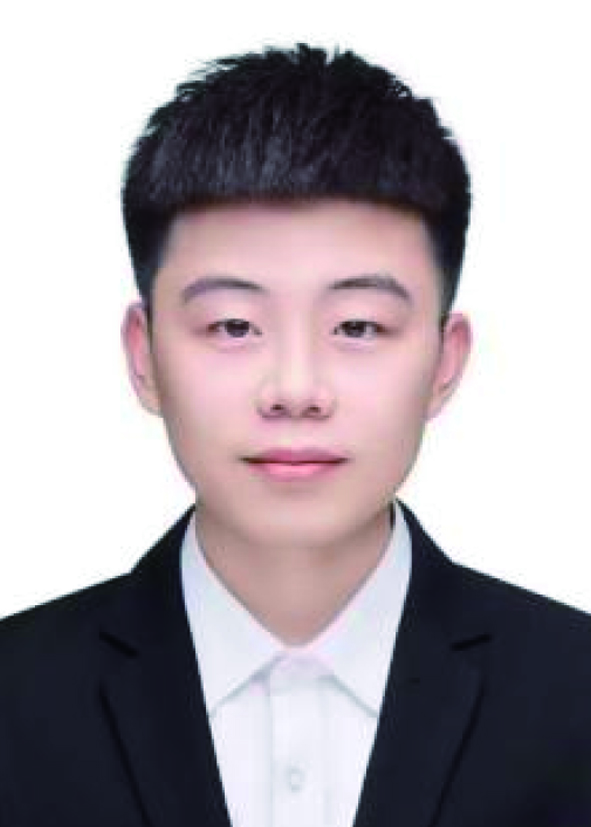 Jinming Bi got his bachelor's degree from Yanbian University in 2021 and his master's degree from Hainan University in 2024. He is currently a research assistant at the School of Physics, Central South University. His research focuses on 2D neuromorphic devices.
Jinming Bi got his bachelor's degree from Yanbian University in 2021 and his master's degree from Hainan University in 2024. He is currently a research assistant at the School of Physics, Central South University. His research focuses on 2D neuromorphic devices. Jie Jiang received BE and ME in electronic science and technology and PhD in physics from Hunan University in 2007, 2009, and 2012, respectively. He was a postdoc in Nanyang Technological University (2012−2013) and Auburn University (2014−2015), respectively. He is currently a Professor in School of Physics, Central South University. His research focuses on neuromorphic materials and devices.
Jie Jiang received BE and ME in electronic science and technology and PhD in physics from Hunan University in 2007, 2009, and 2012, respectively. He was a postdoc in Nanyang Technological University (2012−2013) and Auburn University (2014−2015), respectively. He is currently a Professor in School of Physics, Central South University. His research focuses on neuromorphic materials and devices.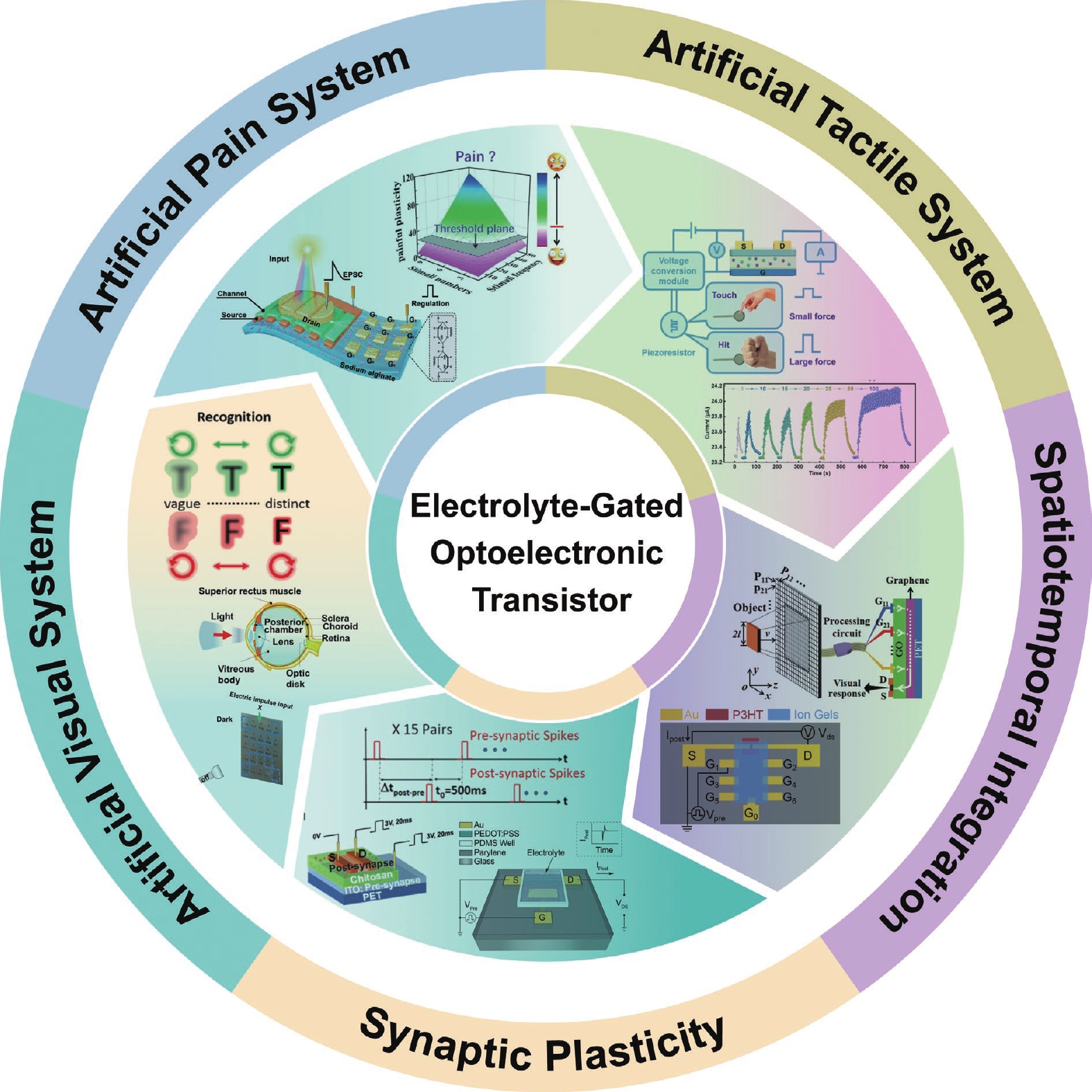
 DownLoad:
DownLoad:
